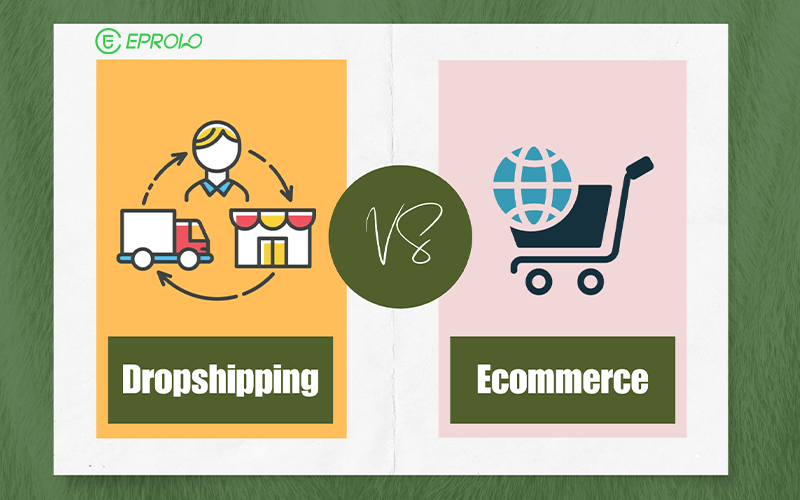If you're thinking about selling online, you've probably heard of ecommerce and dropshipping. They're two popular ways to run an online store, but they're not the same thing.
Dropshipping vs ecommerce often confuses new sellers because both let you sell products to customers without a physical shop. This guide will explain what each one means, the good and bad sides, and help you figure out which one fits you best.

The Basics of Ecommerce and Dropshipping
What is Dropshipping?
Dropshipping is a way to sell products without holding any stock yourself. Instead of buying and storing items, your online store takes orders and passes them on to a supplier for fulfillment.
The supplier then ships the products directly to your customers. So you don't have to worry about managing inventory or packing orders. This makes starting a business easier and less costly.
Main Participants in the Dropshipping Business
Seller of Record
The seller of record is the official person or business responsible for selling the product to the customer. Usually, this is the dropshipper (the owner of the online store), even though the actual product is sent by the supplier.
Dropshipping Suppliers
These are companies or individuals who stock the products and handle shipping. They play a big role in dropshipping because the quality and delivery speed depend on them. The dropshipper works with these suppliers to list products and fulfill orders.
Key Features of Dropshipping
- Low Initial Investment: You don't need to buy inventory upfront. It keeps costs low. This is great if you're just starting out or want to test different products without a big financial risk.
- Platforms for Dropshipping: Many ecommerce platforms like Shopify or WooCommerce offer easy ways to set up a dropshipping store. Some even connect directly with suppliers, making it simple to add products and manage orders.
- Supplier Support: Since suppliers handle stock and shipping, they usually provide support for order processing. So, less work for you, but you also rely on them to deliver on time.
- Order Fulfillment: When a customer buys from your store, the order is sent to the supplier who packs and ships it. You don't handle the product yourself, so it's a hands-off approach to selling.
What is Ecommerce?
Ecommerce, short for electronic commerce, refers to buying and selling goods or services online. Unlike dropshipping, ecommerce store owners usually buy and keep inventory themselves.
So, they store products, pack orders, and ship them directly to customers. Ecommerce can be done through websites, apps, or online marketplaces.
Key Features of Ecommerce
- Product Inventory Control: As an ecommerce store owner, you control which products you keep in stock and how much inventory you hold. This allows you to manage quality and availability directly.
- Fulfillment Process: You or your team handle packaging and shipping orders. This gives you full control over how products are sent, including the speed and presentation.
- Complete Control: Ecommerce gives you the freedom to customize your products, packaging, and overall customer experience. You can create a unique brand that stands out.
- Customer Support: Since you manage everything, you're directly responsible for customer service. You can build strong relationships and quickly solve any issues buyers might have.

Dropshipping vs. Ecommerce: What Are the Pros and Cons?
Trying to pick between dropshipping and ecommerce? Both ways let you sell products online, but they work quite differently.
Dropshipping is like running a store without ever holding stock. In traditional ecommerce, you typically buy, store, and ship your own products. Each comes with its own set of perks and headaches.
If you're just starting out, dropshipping can seem tempting because it sounds easy and cheap. On the other hand, ecommerce can offer more control and bigger profits but needs more upfront cash and effort.
This section will help you weigh the pros and cons of both, so you can figure out which suits you best.
Pros and Cons of Dropshipping
- Low Initial Investment: Dropshipping is great if you don't have much cash to start. You don't need to buy stock upfront. No warehouse or storage needed. You can open your store with just a computer and internet.
- Diverse Product Selection: You can sell a wide range of products. Since you don't hold stock, you can add new items anytime. If something doesn't sell, you just take it off your site. This is great for trying out new ideas or trends without risk.
- Flexible Operating Location: You can run a dropshipping store from home, a cafe, or even while travelling. You only need a laptop and good internet. No need to worry about packing or shipping boxes.
- Easily Test and Add New Products: Want to see what sells best? Dropshipping lets you test new products without buying in bulk. If something doesn't work, no big deal — just stop selling it. This makes it easy to figure out what customers like.
- No Need to Manage Inventory: Your supplier handles stock, packing, and shipping. You just take orders and pass them on. This saves loads of time and hassle.
- High Competition: Because it's so easy to start, dropshipping has tons of sellers doing the same thing. Popular products can be crowded with competitors. You'll need strong marketing and great service to stand out.
- Little Control Over Your Brand: You rely on suppliers for the products and delivery. You don't get to choose how items are packaged or shipped. This can make it hard to build a brand that customers remember.
- Complicated Customer Service: If an order gets delayed or a product is faulty, you have to fix it. But since the supplier handles shipping, you're stuck waiting for them to sort it out. This can frustrate customers and slow down your response.
Pros and Cons of Ecommerce
- Higher Profit Margins: When you buy inventory yourself, you can get better prices by buying in bulk. You can make more profit per sale. You also have more control over pricing.
- Control Over Quality: You handle the products, so you can check quality before shipping. This helps reduce returns and unhappy customers. It also builds trust.
- Custom Products and Branding: You can offer personalized products, special packaging, or bundles. This lets you create a unique shopping experience. Customers love that extra touch.
- Direct Communication with Buyers: You deal with buyers face to face online. This makes it easier to answer questions, solve problems, and build relationships. Happy customers often come back and recommend you.
- Support Brick-and-mortar Stores: If you already run a shop, ecommerce can be a great addition. You can sell online and offline with the same inventory and staff.
- Higher Setup Costs: You need money upfront to buy stock. You also need space to store your products or pay for a warehouse. This adds to your expenses.
- Rising Competition: Ecommerce is booming, so lots of shops are competing for customers. You need a smart strategy and strong marketing to get noticed.
- Managing Inventory Is Hard Work: You have to keep track of what you have, reorder in time, and avoid overstock. This takes time, organization, and sometimes extra staff.
- Risk of Unsold and Outdated Inventory: If something doesn't sell, you're stuck with it. Unsold products tie up money and can become outdated or unwanted.
- Manual Labor Needs for Growth: You'll pack and ship orders, handle returns, and deal with customer service yourself or hire help. As your store grows, you'll need to invest in people or outsource.
Dropshipping is perfect if you want a simple, low-risk way to start selling online. It's flexible and easy to test products. But you give up some control over your brand and customer experience.
In contrast, ecommerce requires more money and effort upfront. But it gives you full control over products, branding, and customer service. It also offers higher profit potential.
Neither model is "better". It depends on your goals, budget, and how much work you want to do. Knowing the pros and cons helps you pick the right path.

Key Differences Between Dropshipping and Ecommerce
Let's look at the main ways dropshipping and ecommerce differ. Knowing these will help you figure out what suits you best.
| Factor | Dropshipping | Ecommerce |
|---|---|---|
| Inventory Management | No need to manage inventory. | You manage the stock. |
| Profit Potential | Lower profit, lower risk. | Higher profit, higher risk. |
| Product Quality | Quality can vary. | Easier to control quality. |
| Fulfillment and Logistics | Depend on the supplier. | The store owner packs and ships orders themselves. |
| Personalized Branding | Limited personalization, relies on supplier products. | Full control to build a unique brand experience. |
| Customer Experience | Rely on third-party suppliers. | Customized unboxing experience. |
| Scalability | Easy to scale with low upfront cost. | Scaling requires investment in inventory and storage. |
| Initial Investment | Low startup cost, no inventory needed. | Capital required for warehousing and fulfillment. |
| Risk | No risk of overstock. | Inventory and overhead increase financial risk. |
Inventory Management
With dropshipping, you don't have to worry about stocking products. The supplier handles all that. You just sell the items, and the supplier ships them out. You won't have piles of boxes in your garage or warehouse.
Ecommerce, on the other hand, involves buying and holding your stock. You have to manage it, store it, and make sure you don't run out or end up with too much. That can get tricky and take up space.
Profit Potential
Dropshipping usually comes with smaller profits per sale. Since you're not buying in bulk, your costs can be higher, and you have to share a cut with suppliers. But the risk is lower because you're not stuck with unsold stock..
Ecommerce lets you keep more profit because you buy products upfront, often at wholesale prices. You get bigger margins but also bigger risks. If things don't sell, you're left holding the stock.
Product Quality
One challenge with dropshipping is that you don't always control the quality. You're trusting the supplier to send best products every time. If they mess up, it reflects badly on your store.
In ecommerce, you get to check the products yourself before selling. That makes it easier to maintain quality and keep customers happy.
Fulfillment and Logistics
In dropshipping, you rely on the supplier to pack and ship orders. That's a relief for you but can sometimes cause delays or mistakes that you can't fix right away.
When you run an ecommerce store, you or your team handle the packing and shipping. It's more work but gives you control over how quickly orders go out and how they arrive.
Personalized Branding
You have limited control over product or packaging branding with dropshipping. That's because the supplier handles the stock and shipping. It's tough to make your store feel unique.
Ecommerce lets you create a full brand experience. From custom packaging to thank-you notes, you get to shape how customers see and remember your store.
Customer Experience
With dropshipping, third-party suppliers handle customer orders. So if there's a problem, you have to coordinate with someone else. That can slow down support.
With ecommerce, you're the direct contact. You can offer quicker replies and personal touches. This helps build trust and loyalty.
Scalability
Dropshipping is easy to scale since you don't carry inventory. You can add new products fast and expand without worrying about storage or extra staff.
Ecommerce needs more investment to grow. More products often lead to more stock, bigger warehouses, and possibly more employees. It can be a bigger commitment but also a bigger payoff.
Initial Investment
Dropshipping has a low startup cost because you don't buy inventory upfront. You mainly spend on setting up your store and marketing.
Ecommerce requires more capital from the start. You'll need money for stock, storage, shipping supplies, and maybe a team to help.
Risk
Dropshipping lowers your risk because you don't own the products until they're sold. No inventory means no leftover stock.
Ecommerce carries a higher risk. Unsold products and overhead costs like rent or staff can add up if sales don't meet expectations.
Which Is Better for You: Dropshipping or Ecommerce?
Trying to figure out whether dropshipping or ecommerce is better for you? It comes down to what you want, how much money you have, and how much work you're ready to put in. Both have their ups and downs.
So in this part, we'll help you see when dropshipping makes sense and when ecommerce can be the way to go. Whether you want to keep things simple or take full control, this will help you decide what fits you best.
When to Choose Dropshipping
Dropshipping is a solid pick if you're just dipping your toes into the online selling world and want to launch your store fast.
You won't need a big pile of cash to get started, so your money stays safer. Plus, no stressing about buying or storing products. Someone else handles that for you.
Here are some scenarios where dropshipping really shines:
- You're new and want to avoid the hassle of managing stock or a warehouse. No need to worry about where to keep products or how to ship them. That's all taken care of by someone else.
- Your budget is tight, and you want to keep risks low. You don't have to spend lots of money upfront on products that do not sell, so you keep your wallet safe.
- You're in a fast-changing market like trendy clothes, gadgets, or seasonal items where products come and go quickly. Dropshipping lets you quickly add or remove products without being stuck with old stuff.
- You want to try out different products to see what sells without buying lots of inventory upfront. Test different ideas easily without spending a fortune on the stock you do not need.
- You like working from anywhere without being tied to a storage space. No warehouse or storage allows you to run your store from your laptop, wherever you are.
When to Choose Ecommerce
Ecommerce is the way to go if you have some cash saved up and a few people to help you run things. Owning your stock lets you call the shots, from product quality to packaging and delivery speed. This helps build a strong, memorable brand that customers trust and love.
You'll want to consider ecommerce if:
- You've got the funds to invest in buying and storing your products. You can buy stock in advance and keep it safe, so it's ready to send out as soon as orders come in.
- You care about how your products look and feel when customers open them. You get to choose the packaging and make sure customers get a great "wow" experience.
- You want full control over the entire shopping experience, from website to unboxing. Everything from order to delivery is in your hands, so you can make your brand stand out.
- You're ready to build a brand that's unique and stands out from the crowd. By owning your inventory, you can make your products truly special instead of selling the same as others.
- You want to boost your profit margins by cutting out middlemen. Selling your own stock allows you to keep more of the money customers pay.
- You have the time and team to manage inventory and shipping. Managing stock and packing orders takes work, so you'll need people or time to do it well.
Conclusion
Choosing between dropshipping and ecommerce just depends on what feels right for you. Dropshipping's great if you want to keep things easy and cheap to start. Ecommerce works better if you're ready to invest some cash and time and want full control over your brand.
Think about what you want, how much you've got to spend, and how much work you want to do. Either way, choose what fits your vibe and goals.
FAQs
Is dropshipping the same as ecommerce?
Not exactly! Dropshipping is a type of ecommerce where you don't keep products in stock. Ecommerce consists of dropshipping and selling your own inventory.
Is Shopify for dropshipping or ecommerce?
Shopify works for both! You can run a dropshipping store or manage your inventory. It's super flexible.
Can I combine dropshipping and traditional ecommerce?
Absolutely! Many sellers mix both to test products and grow their brand without too much risk.
Do I need a large amount of money to start a dropshipping business?
Nope! Dropshipping lets you start with very little money since you don't buy stock upfront.
Which business model is more profitable in the long term?
Ecommerce often brings higher profits later on, but dropshipping is easier to start and grow without much risk. It depends on your goals!







